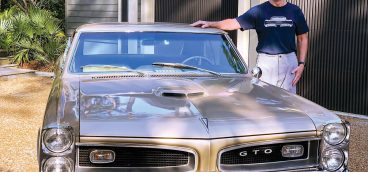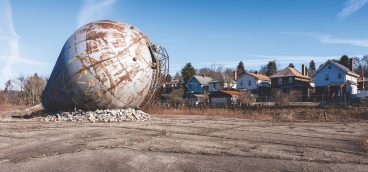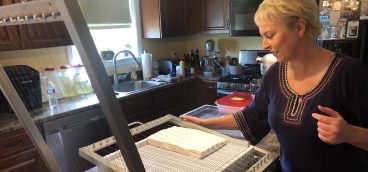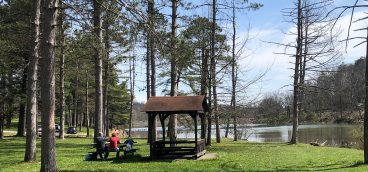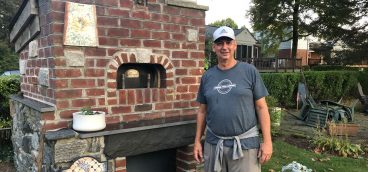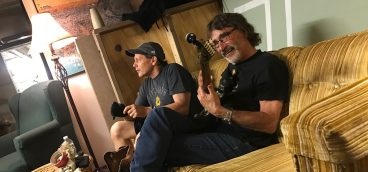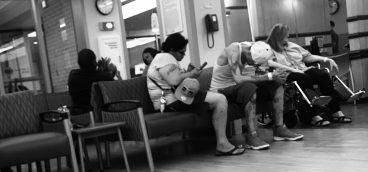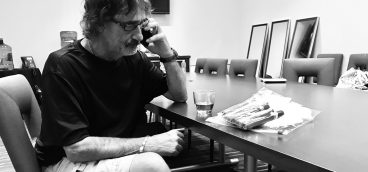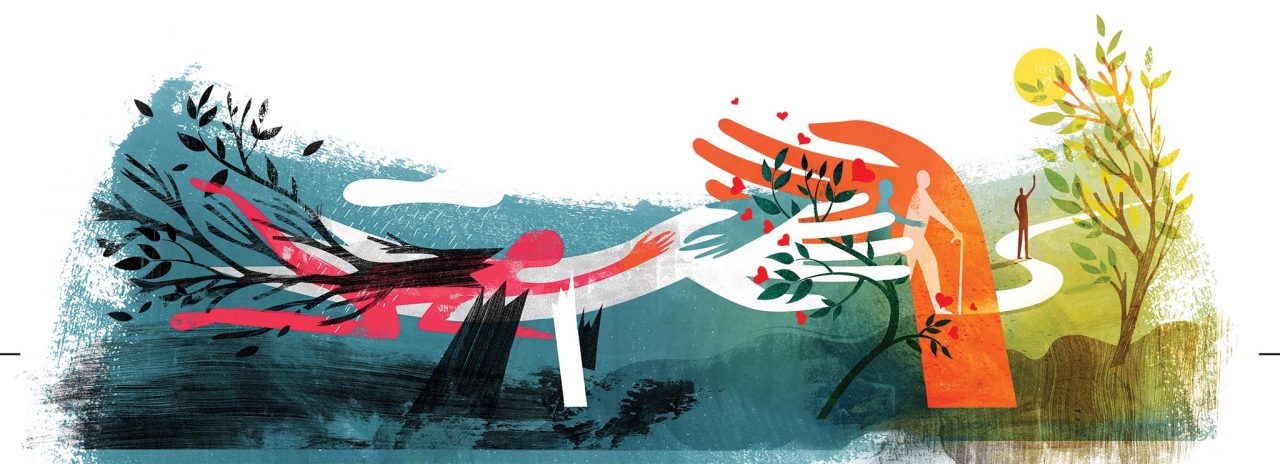
I had been running under trees, in forested or suburban settings, for well over 40 years. And of course, I’d been walking under them my entire life. I considered them shelter-providing, oxygen-producing, noble organisms — friends to the runner on warm, sunny days. I’d seen them split, splintered, and sundered by winds and storms. Occasionally I’d encountered them after they had rolled over and crashed onto the ground. But I never feared them. When did trees fall over? Who knew? They just seemed to be downed, and you passed them, impressed by the bulk and complexity of the root ball; then they lay there, decomposing, for years. Like everyone else I wondered: if a tree fell in the forest, and no one was around, did it really make a sound?
All of this shifted radically for me on one cool, misty October afternoon as I ran my usual route through the tree-lined streets of Mt. Lebanon. I learned, incontrovertibly, that a falling tree makes a hell of a noise, usually because it is falling through other trees and their branches, and perhaps through phone poles and power lines, as it violently descends. You can definitely hear it. It commands your attention like a thunderclap or a roaring freight train.
On that afternoon in 2019, an enormous oak tree toppled onto me as I trotted under it. Suddenly, I found myself pinned to the wet pavement by huge branches and dripping vegetation, trying to put together what had happened. I was aware that I could not move my right leg, which now extended from my body at an impossible angle. My shoulder hurt, but I was yet breathing and could move all my fingers and toes. I became very cold and began to shiver violently.
Someone called out to me. “Don’t move…the power lines are down.”
I didn’t bother to say that I actually couldn’t have moved, even if I’d wanted to. I wondered vaguely if I would be electrocuted. A small audience had gathered, and one woman, a kind soul who’d ventured out with her granddaughter, risked her own safety to bring me a blanket, an act of selflessness that I’ll not forget. Sirens blared, and the police, firemen and paramedics joined the ring of onlookers. I looked at them, stunned, awaiting the men from the power company to enable my rescue. When they finally arrived, I could hear helicopters above — apparently the event was newsworthy. Weeks later, I consulted the internet to find the newsfeed. “A 58-year-old man was struck by a tree as it fell and was taken to the hospital with non-life-threatening injuries.” Reading such words about yourself is a singular event.
The paramedics were sturdy, professional, upbeat, even jocular. I asked to go to St. Clair’s ER, just a mile away.
“Sorry doc.” By this time, they’d learned that I was an anesthesiologist at the UPMC.
“We gotta get you to a trauma center.”
I was cold, concussed and feeling the pain more keenly. But this news was startling. There are several scenarios in which a health care provider never wants to find himself or herself. One is a full-fledged code, with CPR and defibrillators; the other is being the object of a trauma resuscitation.
But I was in no position to argue. “Presby?” I asked, weakly.
“Mercy is closest.”
I was relieved. Since I worked at Presbyterian and Montefiore, it wouldn’t do to be stripped down and evaluated from head to toe by my coworkers and their trainees, particularly since I am no anatomic marvel.
“How bad is the pain, doc?”
Mercifully, they’d begun to warm me, with blankets and the heaters in the ambulance. The pain was becoming more agitating by this point.
I thought about the pain scales that we presented to patients daily in the recovery room. “On a scale of zero to 10, with 10 being severe pain…” I didn’t want to seem too affected by my injuries. “Maybe a six or seven?”
“Let’s get you some fentanyl. A hundred micrograms?”
I’d had the drug a few times for procedures. Profound pain relief, a sense of pleasure, but also intense nausea, at least for me.
“Could we go with a lower dose — say 25 mics?”
The two medics were interested to note that I was participating in my own dosage.
We rolled into the ER at Mercy, where an assembly of terse, dutiful providers anxiously awaited the incoming trauma patient — me. Predictably, word of my arrival had spread. I know some of the people at Mercy, including virtually all of the anesthesiologists. The chief of the division, a delightful, energetic, fireball of a woman, had once been one of our residents, and later she was my esteemed colleague at the small South Side facility across the river. Monica greeted me with sympathy, kindness, and a bit of humor.
“I was hoping it wasn’t you.”
“Unfortunately, it’s me.” I didn’t know what else to say, but I tried to smile.
The pit crew got busy with the trauma routine:
“Deep breaths…good…hold it…X-ray…open your mouth wide…does your neck hurt?…this clavicle fracture looks open…first rib fractured…small pneumothorax…his coma scale is 15, but he got a good blow to the head…small scalp LAC…we can close it later…hip is shattered…he’ll need urgent OR…the FAST exam is negative…thigh is very swollen…could have a liter of blood in there…vitals are pretty stable…get him an ICU bed while we wait for surgery.”
All were words I’d uttered at some point in my life, when caring for trauma patients as an emergency physician or anesthesiologist, or during my year of critical care training. Always for other people, of course; I never imagined that I would be on that table.
“Does that hip fracture hurt a lot?” A young man from the emergency medicine team looked earnestly at me.
“We could do a nerve block for you. You know, a fascia iliacus block in the groin to help with the pain.”
I uttered a short laugh. “I do nerve blocks pretty much for a living.”
He patted me on my unaffected shoulder. “I know. You can look at the ultrasound with us…maybe give us some pointers!”
“Sure.”
I’d had only one prior nerve block, for a foot surgery, two decades before. Peripheral nerve blocks in the arms and legs constituted a major part of my daily life in anesthesia, and I was keen to have a block for my hip fracture.
There was general amusement that a regional anesthesiologist was helping to oversee his own nerve block. They knew what to do; I simply affirmed it. I watched on the screen in fascination as the needle entered my upper thigh, and the local anesthetic was injected under the appropriate tissue plane, not far from the femoral nerve. There was no pain. Perhaps too many other parts were smarting.
Soon the trauma surgeon, a slight, serious, attractive woman, presented the X-ray findings to me. I knew her, too, from her days in residency when she’d rotated with the sports orthopedic surgeons at South Side.
“This is a peri-trochanteric fracture. We need to put all these parts back together,” she indicated, pointing to various pieces of bone that had been torn from the femur. “And get some hardware in there to stabilize the hip fracture itself. And that clavicle fracture is unfortunately open — we’ll have to wash it out and plate it. We’ll do you first thing tomorrow. Tonight you’ll stay in the ICU. The neurosurgeons will be by to see you…”
I thanked her sincerely, and was soon moved out of the ED.
“You’ve got a subdural bleed…and subarachnoid blood. It doesn’t look surgical, though, according to the trauma docs.” My ICU nurse was kind enough to explain the situation with my head injury.
“My leg feels like a sausage.”
She nodded. “Yep. That’s the nerve block.”
I tried to move my fractured leg. The muscles of my thigh would not obey my brain. The leg felt like it was not my own, as though someone else’s limb had attached itself to me. I kept touching it, expecting to feel something, but I could not. I’d rendered many patients weak and numb in either their arms or legs, but I’d forgotten what this felt like. At this point, my hip and leg no longer hurt, and for that I was most grateful.
My wife and daughter stayed with me that evening and the next day, humoring me and offering emotional support. Their warmth and kindness were worth a pharmacopoeia by themselves. Various luminaries from the anesthesiology department and even the orthopedics department stopped in to visit; I was honored by their attention. When it came time for me to go to the operating room, a young man in scrubs approached, somewhat timidly. I recognized him immediately — one of the dental anesthesiology residents. I had supervised him as he was performing anesthetics at my own hospital just a week or so before. Now, he was rotating at Mercy. And he would be taking care of me. The ironies and coincidences never seemed to stop coming, but I felt secure knowing that someone familiar would be watching over me while I embarked on my brief journey of drug-induced unconsciousness. Even the bravest souls feel some trepidation at the idea that uncontrollable forces will render them unconscious, insensate, immobile.
Supposedly it took five hours, but I woke up right after I went out. There was pain, but it was not intolerable. Pain in two places, from two surgical procedures. I remarked on this to myself — each site competed with the other to see which could dominate my attention. First the shoulder, then the hip, then the shoulder again. They never seemed to make their way into my consciousness at the same time.
I had spent years encouraging patients to take fewer opioids, all the while providing nerve blocks to reduce the need for them. The responsibility that physicians bore for the opioid crisis had been seared into all of us by public health experts, researchers, and government administrators. I was now determined to minimize my own opioid consumption — I felt I owed it to all those people whom I’d encouraged to reduce their use of the medications. But that first night, in the ICU, I knuckled under and accepted two doses of intravenous hydromorphone from the nurse, who was very attentive to my needs.
During the aftermath of my surgery, I learned firsthand that, at night, pain becomes a demon. As though it stalks you. During the daylight hours, the appearance in my room of doctors on rounds, family, nurses, phlebotomists and therapists all helped to keep the discomfort at bay. But when the sun set, the lights dimmed, the TVs down the hall fell silent, and all the visitors left for home — then, the throbbing or searing or gnawing began to exert itself, and I looked wearily at another long night, alone in a hospital bed.
My recovery was prolonged and demanding. On my first day home, in the cool of the autumn afternoon, my wife took me to the local track and declared that I should wheel myself around it, twice. The next morning, she insisted that I get into the pool at the nearby community center, a feat that required use of the crane for handicapped access. Briefly, I was terror-stricken as the chair was lowered down, and my atrophied legs were enveloped by the cold water. I began a grueling campaign of doggy-paddling with one arm and one leg, stretched over a boogie-board, forcing myself back and forth along the length of the pool. I couldn’t stay in very long, as I became hypothermic very quickly, cramping and shivering. But it was a start.
After the outstanding rehabilitation care I’d received at Mercy before my discharge, therapists visited me at home for a few weeks. Once I graduated from wheelchair to walker, I began physical therapy in earnest at the Freddie Fu center on the South Side. I was charmed when Dr. Fu himself, with whom I’d had the privilege to work with for two decades, sent me daily texts with pictures of beautiful flowers, sunsets, bonzai trees…anything natural and inspiring. He was overseas, but having heard of my accident, he did not forget me.
It would be a number of months before I cautiously began running once more. I would never again be as swift as I had been, but it was deeply satisfying to be able to run at all. And, while slower, I had emerged spiritually stronger. When I hobbled into our education office on my cane to deliver a lecture to our residents just before I returned to work, they presented me with a new OR cap: “Iron Man.” It was a moving tribute, and I choked up — I really couldn’t speak for a few moments.
After nearly four months of surgery, recovery, inpatient rehabilitation and outpatient physical therapy, I was given the green light to go back to work. Arriving at our office at six o’clock on my first day, I was greeted with a “Welcome Back!” banner. Anesthesiologists are not, as a rule, emotional people. This sentiment meant a great deal to me: I thought I’d been forgotten, but my colleagues tacitly recognized what I’d been through. After six weeks in a wheelchair, a month on a walker, and nearly four weeks leaning on a cane, I was at last walking independently. A few weeks earlier, at my family’s Christmas party, I had accidentally picked up my mother’s cane, which looked almost identical to mine. In that awkward moment, she and I put our heads together and laughed heartily; it was still the pre-COVID era.
Changing into my scrubs, I headed up the long set of stairs that led to the OR so I could meet my patients. I used the rail and walked stiffly, one step at a time. I refused to use the elevator, though I admit that courageous decision was compromised as my day wore on.
There is no doubt that the kindness, affection, and support of the people around me — colleagues, family, friends — elevated my spirit and enabled my recovery. And I have been able, since my trauma, to identify more soulfully with suffering patients. This is a great gift, as is a return to physical capability. Though I had spent many hours wondering why this random event had happened in my life, and why I was spared death, paralysis or an unrecoverable brain injury, those questions no longer hold meaning. Ministering to the ill and injured, guiding them through the surgical process, addressing their suffering — this is a wonderful way to spend a life. My experience had given me a more profound appreciation of this than ever.
Dr. Steven Orenbaugh’s novel “The Stairs on Billy Buck Hill” was published by Sunbury Press in January.


